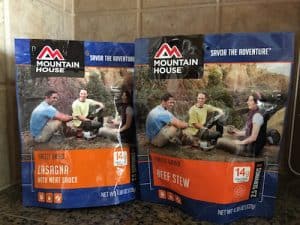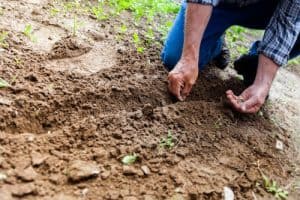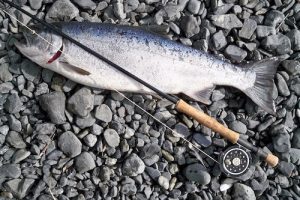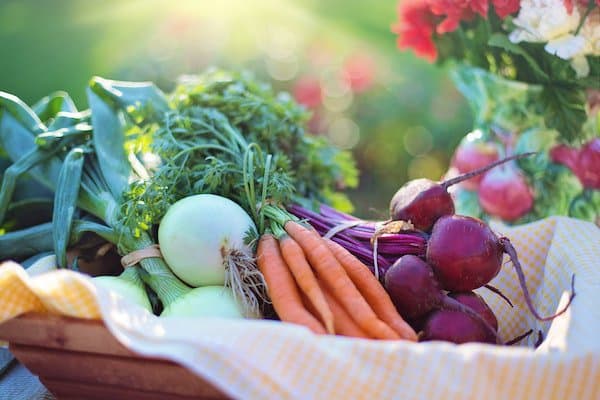One of the most important parts of being a prepper is developing a food supply plan. Your plan should involve storing food and having a way to replenish it over time.
Preppers can create their food storage in a variety of ways. They can purchase a large quantity of it all at once or they can build it in stages. However, even if you are able to store a year’s worth of food (or more), you should also plan to grow or harvest additional food as well.
This article will show you how to develop a prepper food storage and supply plan. It will help you build your food storage in an organized way, show you what to store, and give you ideas for how you can replenish your food supply over time.
How to Build Prepper Food Storage
A comprehensive prepper food storage and supply plan should be designed to last you through any emergency, no matter how long or short it may be. If you don’t have any food storage yet, start building it using whatever your budget can handle.
If you can swing it financially, one of the large 1-year supply deals may be a good idea. However, most of us cannot afford to do this. If you are on a budget, start your plan small and build it over time. Consistent small victories are the key to making long-term progress. I have found that the best way to make progress is to build your food storage in stages.
How to Build Your Prepper Food Storage In Stages
Stage 1: 3-Day Food Supply
If you haven’t started to build your food storage, the first step you will need to take is to build a 3-day food supply. This is the amount of food the federal government recommends that you keep on hand for emergencies.
Although it isn’t nearly enough to last you through most situations, it is a good place to start. If you are short on cash, purchasing canned soups and vegetables is a cheap way to get started. Dried beans and rice are good options as well.
Whatever you store, make sure that it is easy to cook (even without electricity) and has a shelf life of at least a few years. Include foods that will suit the dietary needs and tastes of everyone in your family.
Emergencies are hard enough without having to worry about a hangry spouse or teenager. If you have young children, be sure that you include what they need as well, including powdered formula for infants.
If you have a baby, take a look at my article, Prepping with a Baby. It includes information on how to store food for your little one as well as other things you need to think about when you have young children. You can see that article by clicking here.
If you don’t have any food set aside for emergencies, go out and purchase your 3-Day food supply today. It is better than nothing, and it can be the first step you take towards being prepared.
Stage 2: 1-Week Food Supply
After you have built a 3-day food supply for you and your family, take another small step and increase your storage to 1 week’s worth of food. Instead of just buying duplicates of what you have already stored, add new foods to give variety. Eating too much of the same thing is bad for morale and can even cause illnesses.
Having a 1-week food supply will help you get through small-scale weather events such as short freeze-ins. If you haven’t done so already, now would be a good time to start adding freeze-dried foods to your prepper food storage. Some of these will last for up to 30 years, making it easy to build up your stores over time.
Stage 3: 2-Week Food Supply
For your 2-Week food supply, continue to add new types of food for variety and add more of what you already have stored. Build up a variety of freeze-dried foods, canned goods, and staples (rice, sugar, and grains). Be sure that you know how to prepare anything that you have stored.
Stage 4: 1-Month Food Supply
Continue to add freeze-dried foods, canned goods, and staples to your food storage. Be sure that you have taste-tested any items that you don’t normally eat, such as the freeze-dried stuff. Also, know how to cook with any of the staples you have stored and take special care to rotate your canned goods.
Once you have a month’s worth of food storage, start to add renewable food sources, such as a garden. If it isn’t the best time to start planting, go ahead and purchase heirloom seeds and other supplies so that they will be ready.
If you hunt or fish, gather supplies, such as ammunition or lures. This will help you make sure that you have what you need to harvest game animals or fish.
Stage 5: 3-12+ Month Food Supply
Continue to increase your food storage and your ability to grow or harvest food. If possible, store some of this at your bug-out location or somewhere else that is secure but separate from your home. If your home is destroyed, this will help prevent you from losing all of your preps.
Once you start to have this much food stored, operational security will become very important. Although you should always practice good Opsec, having this much food will make you a target during a prolonged emergency situation.
If people know that you have large food storage such as this, you could find yourself in a really bad situation. What may start as funny discussions at a baseball game about the paranoid neighbor with the big pile of food may turn into a raiding party during an emergency.
Types of Foods Preppers Should Store
Canned Food
The first layer of a prepper’s food supply should be canned food. Canned food is cheap, easy to store, and readily available pretty much anywhere. Your canned food supply should consist of different types of foods, such as meats, vegetables, fruits, and soups.
Most canned foods should last around a year or two before expiring, however, this can vary widely depending on what type of food it is and where it is stored. They have a much shorter shelf-life than freeze-dried foods, but they can still be beneficial if you practice smart buying and use habits.
When storing canned goods, be sure to only buy what you would normally eat and rotate it. You can purchase or build your own can rotator systems. Some are small enough to fit in a pantry while others are large enough to be separate stand-alone units.
Staples and Grains

The next layer of a prepper food plan should consist of staples and grains. These are ingredients that serve as the foundations for numerous recipes and in many cases stand-alone foods. They include salt, flour, sugar, rice, and cornmeal among many others.
Many preppers like to transfer them into mylar bags for long-term storage. Before sealing the bag, they will add a desiccant to remove moisture. They will then seal the bag and place it in a 5-gallon food-grade bucket. This will protect the food from pests and help give it really long shelf life.
Freeze-Dried Foods

Freeze-dried foods are an excellent investment for preppers who want a long-term food storage solution. Since freeze-dried foods have a long shelf life, you can store large quantities over time without having to worry about earlier storage expiring. Some of the most popular companies for freeze-dried foods are Mountain House, Augason Farms, and Wise.
Click here for my review of Mountain House freeze-dried foods.
Renewable Food Sources for Preppers
A good prepper food supply plan does not just involve storing large amounts of food. Given enough time, even large amounts of food storage could run out, be stolen, or be ruined by a flood or fire. Because of this, a prepper food supply plan should also have renewable elements. This will help your food storage last longer and provide nutrients that stored foods may not. Using renewable food sources requires skill and practice to master. It is a good idea to begin implementing these before an emergency happens.
Home Garden

A home garden is a valuable prep that even non-preppers can enjoy. You can grow your favorite fruits, vegetables, and herbs right in your own yard. If you don’t have much space, you can use pots to form a container garden. Although it can be rewarding, there is a learning curve. You have to know what plants do well in your area and how to take care of them.
Do not be the guy who buys several hundreds of dollars worth of seeds and has no idea how to use them. Buy the seeds, but start developing your green thumb as soon as possible. Plants can take months, sometimes even years, before they start to grow food.
When buying seeds, be sure to buy heirloom seeds. You can harvest them from the crop you grow to produce plants again next year. Hybrid seeds, on the other hand, cannot be reused, making them a poor choice for preppers.
Animal Husbandry

When most people think of animal husbandry, they think of a large farm with dozens of animals. However, even if you don’t have enough space for large livestock, you may be able to raise smaller animals. Chickens and rabbits are excellent animals for people who are low on space. Rabbits reproduce rapidly, giving you a constant food supply. Chicken is a very common part of the American diet, and they provide the added benefit of laying eggs.
If you have space, larger animals, such as goats, pigs, and even cattle would be very valuable additions to your prepper food supply plan. However, these would likely require greater manpower and resources than smaller animals.
Aquaponics
Aquaponics is a really neat method of food production. It consists of water tanks that contain fish with edible plants growing above them. The plants’ roots dip down into the water tanks which provide a home for the fish. The plants get nutrients from fish waste, cleaning the water at the same time. Humans get food from both the fish and plants that grow within the self-contained ecosystem.
Although aquaponics is a great way to have a renewable food supply, it does have a couple of drawbacks. Most aquaponics systems rely on electric pumps to keep water moving where it needs to go within the system. Because of this, you will need a solar power system to keep everything running in a grid-down situation. In addition, building an aquaponics system can be pretty expensive.
Hunting and Trapping

Hunting and trapping are valuable skills for a prepper to learn to replenish their food supply. Both require their own specialized skills and equipment and are better learned before an emergency takes place.
To be an effective hunter or trapper, you will need to learn how local species behave, what kind of tracks they leave, and the best ways to harvest them. Large animals, such as deer, are better hunted using firearms or archery. Small animals, such as rabbits and squirrels can easily be caught with different types of traps and snares.
You will also need to know how to process animals after you have harvested them. Being able to gut, skin, quarter, and process the meat will be an essential skill. In a long-term grid-down situation, knowing how to preserve the meat long-term will be extremely valuable.
Fishing

In addition to being a fun past time, fishing is a very good way for a prepper to supplement their food supply. If you live near a sea coast, lake, or river, fishing is something that you should definitely add to your food resupply plan.
You can catch fish using a rod and reel as well as other methods such as trotlines or baskets. Be sure you know your local rules and regulations for fishing. You don’t want to get fined for practicing your prepper fishing techniques.
Foraging

Foraging for edible plants is a great skill to learn but is something that you need expert instruction for. Many edible plants have poisonous lookalikes that can make you sick. Some of these poisonous lookalikes are toxic enough to kill an otherwise healthy person in a matter of minutes.
To stay safe, buy several reference books and get instruction from a mentor or class. They can teach you how to stay away from dangerous plants and give you tips and tricks to help you get the most out of the wild plants in your area.
Have a Supply of Dietary Supplements
While you should design your prepper food supply to address all of your dietary needs, you may need dietary supplements to fill any gaps. Some conditions, such as scurvy, are the result of a vitamin deficiency. Having dietary supplements on hand and using them daily will help you make sure that your diet contains all of the vitamins and nutrients your body needs.
Other Things Preppers Should Consider
How Will You Cook?
During an emergency, utilities such as electricity and natural gas will likely be unavailable. Because of this, you need to have off-grid cooking methods. For short-term emergencies, using your charcoal or gas grill would be suitable as long as you have stored enough fuel. Small propane camping stoves would work nicely as well.
For long-term emergencies, you will need to rely on other methods, such as wood-burning stoves, fire pits, or outdoor rocket stoves. Some of these can be purchased, but you can build others using natural or salvaged materials.
Don’t Forget Your Pets
Make sure that you build food storage for any pets that you have. If you are like me and my wife, your animals are part of your family. Having food for them is a responsibility that shouldn’t be overlooked. Also, your pets may serve vital survival roles.
Dogs are well-known for alerting their owners of danger and even defending them. Cats are excellent at hunting pests such as rats, which will help prevent an infestation. Both will serve their roles much better if they are properly fed.

